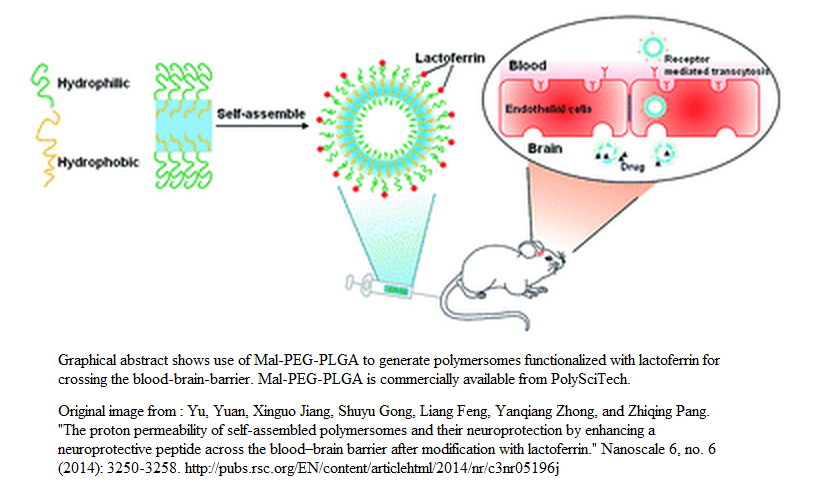PolySciTech (
www.polyscitech.com) provides a variety
of PLGA-PEG-Maleimide reactive precursors (PolyVivo AI20, AI53, etc.) for conjugation
to peptides and other targeting moieties. Recent research has shown that
functionalization of these polymers with lactoferrin allows for transportation
of the polymersomes across the blood brain barrier. Read more: Yu, Yuan, Xinguo
Jiang, Shuyu Gong, Liang Feng, Yanqiang Zhong, and Zhiqing Pang. "The
proton permeability of self-assembled polymersomes and their neuroprotection by
enhancing a neuroprotective peptide across the blood–brain barrier after modification
with lactoferrin." Nanoscale 6, no. 6 (2014): 3250-3258. http://pubs.rsc.org/EN/content/articlehtml/2014/nr/c3nr05196j
“Abstract: Biotherapeutics such as peptides
possess strong potential for the treatment of intractable neurological
disorders. However, because of their low stability and the impermeability of
the blood–brain barrier (BBB), biotherapeutics are difficult to transport into
brain parenchyma via intravenous injection. Herein, we present a novel
poly(ethylene glycol)–poly(D,L-lactic-co-glycolic acid) polymersome-based
nanomedicine with self-assembled bilayers, which was functionalized with
lactoferrin (Lf-POS) to facilitate the transport of a neuroprotective peptide
into the brain. The apparent diffusion coefficient (D*) of H+ through the
polymersome membrane was 5.659 × 10−26 cm2 s−1, while that of liposomes was
1.017 × 10−24 cm2 s−1. The stability of the polymersome membrane was much
higher than that of liposomes. The uptake of polymersomes by mouse brain
capillary endothelial cells proved that the optimal density of lactoferrin was
101 molecules per polymersome. Fluorescence imaging indicated that Lf101-POS
was effectively transferred into the brain. In pharmacokinetics, compared with
transferrin-modified polymersomes and cationic bovine serum albumin-modified
polymersomes, Lf-POS obtained the greatest BBB permeability surface area and
percentage of injected dose per gram (%ID per g). Furthermore, Lf-POS holding
S14G-humanin protected against learning and memory impairment induced by
amyloid-β25–35 in rats. Western blotting revealed that the nanomedicine
provided neuroprotection against over-expression of apoptotic proteins exhibiting
neurofibrillary tangle pathology in neurons. The results indicated that
polymersomes can be exploited as a promising non-invasive nanomedicine capable
of mediating peptide therapeutic delivery and controlling the release of drugs
to the central nervous system.”


No comments:
Post a Comment